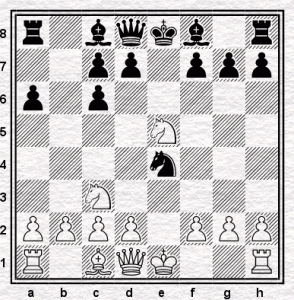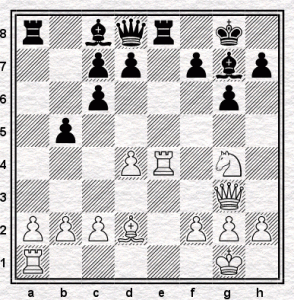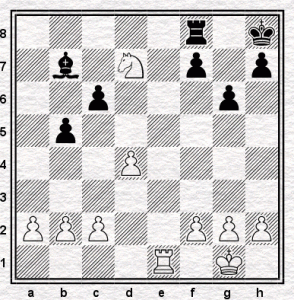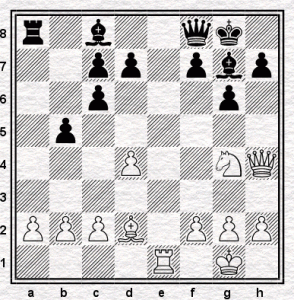I’ve decided to separate the actual chess GAME I played last week, and that I was talking about in the last post, into a separate post here. The main reason for this is that specifically chess analysis-related comments can now go here, while anything else can go on the previous post.
So… arriving for my second competitive league chess match last Tuesday, I was shocked and appalled to discover we were playing a local junior club.
I say ‘appalled’, of course, because no adult player likes playing against junior players. And I ought to know, since I was, throughout my playing days in the 70s, the junior.
There are various reasons adults dread playing juniors in chess. One is that young players usually play incredibly quickly, making it all look terribly easy, while you are desperately trying to kick-start your ageing synapses.
Another reason is that you never know quite how good junior players are (since they tend to improve rapidly in their teens), but they are usually far better than you are told they are.
A third reason is that you are on the proverbial hiding to nothing.
Win the game, and someone will say: ‘Well, s/he was only a kid’.
Lose the game, and you lost to…a kid.
Finally, there is the worry that losing to a player over thirty years younger than you will focus your mind yet again on the topic of ageing and mental decline. Not a comfortable thought when you are approaching your 6th decade. It feels bad enough having to go to research seminars where people bang on about Alzheimer’s, Tau, gamma-secretase, Presenilins and all that depressing stuff.
Anyway, I sat there waiting for the game to start with an odd feeling of sympathy for all my long-ago adult opponents.
And so to the game.
———————————————————–
White: A Elliott Black: D Bowden 19th July 2011
1. e4 e5
2. Nf3 Nf6
Que..? I wasn’t expecting that! Black’s second move introduces Petrov’s Defence, aka ‘The Russian Game’. When Black played this move, I tried to remember if I had ever faced it in a proper game – and I couldn’t remember a single one. Going to my archive later (!) I find I had it played against me once, in a school U-18 match in early 1976. That game continued 3. Ne5: Ne4:? (..d6 is the standard move) 4. Qe2 Ng5?? 5. Nc6+ (oops) and I managed to win with my extra Queen.
Since my opponent in the present game was a keen-looking 13-and-a-bit year old, I suspected he would have read a book, or possibly two, about what should happen after any standard continuation. So I tried to confuse him with:
3. Nc3 Nc6
– and now we have the Four Knight’s Game, which every chess player has played at least once, and which has a reputation for innocuousness.
When I looked through the archive I found, again, just one game from my playing days featuring the Four Knights, though reached by a different move order. This was one of the earliest games I have recorded, played when I was about the same age as my current opponent. I have had the position more recently in one or two games against the online version of the Shredder chess programme.
Which is another story… because in those computer games I was messing about playing the so-called ‘Halloween Gambit’, which is (in this position) 4. Ne5:?! This piece sacrifice cannot really be sound, but it leads to interesting play if Black tries to hold on to the sacrificed Knight, usually with White trying to checkmate a Black King which is often stuck in the centre.
Anyway – I sat there, wondering if I dared to play the gambit in a sort of serious over the board game. What if I lost? The rest of the team might quite reasonably think I had been taking the piss.
Another thing that spoke against daring the gambit was that all my games in this line with Shredder have followed one particular sub-variation of the Halloween Gambit. This is one of the things about chess computers – give them the same position, especially early in the game, and they will often make precisely the same move. But what if Black were to play something different, and that I’d never seen?
Anyway, after a few minutes vacillating I chickened out, and played the staid:
4. Bb5
His next move surprised me a bit too, especially as he played it almost straight away:
4. ….a6
The question here is whether White can actually win a pawn by Bc6: and then Ne5: The answer is ‘no’, but it looked like it would lead to some sharp play. Since the Four Knights has such a reputation for draw-ishness (notably after 4. …Bb4), I decided to have a go.
5. Bc6: bc:?!
6. Ne5:
– which looks a bit like it wins a pawn – but:
6. …Ne4:
The usual 5th move for Black in this variation is 5 …dc:, so that after 6 Ne5: Ne4: 7. Ne4: …Qd4 wins back the piece, though the variation is supposed to be favourable for White after (say) 8. 0-0 Qe5: 9. Re1 Be6 10. d4
[For instance, a game I found on a Russian chess server, D Borisyuk – M Kotsjubinsky ran:
1. e4 e5 2. Nf3 Nc6 3. Nc3 Nf6 4. Bb5 a6 5. Bc6 dc 6. Ne5 Ne4 7. Ne4 Qd4 8. 0-0 Qe5 9. Re1 Be6 10. d4 Qf5 11. Bg5 h6 12. Qd3 Kd7 13. Bh4 Re8 14. c4 Kc8 15. Qc3 Kb8 16. Bg3 Bd7 17. f3 h5 18. h4 Be7 19. Rad1 Qg6 20. Qa5 Bd8 21. Re3 Bc8 22. Rb3 Ka8 23. Bc7 Bh4 24. Qb6 Bd8 25. Bd8 Rd8 26. Nc5 Qc2 27. Rf1 Qc4 28. Rb4 Qc2 29. Nb7 1:0]
The equivalent idea after 5 …bc: 6. Ne5: Ne4: 7 Ne4: is ..Qe7, winning back the Knight. I probably should have played this, since there look to be several good continuations for White, e.g. 8. d4 to follow either ..d6 or …f6 with 9. 0-0 and 10. Bg5, or simply 8. 0-0 Qe5: 9. Re1 Be7 10. d4 and 11 Bg5.
I didn’t know all this, though the variations are pretty obvious. Anyway, for reasons best known to myself – probably the desire the complicate and to keep more minor pieces on – I played something different.
7. Qh5?! Nd6
Forced, as after ..Qe7 8 Ne4: the White N on e5 is protected.
8. d4 g6
9. Qf3 Bg7
10. 0-0 0-0
11. Re1 Nb5
Black’s 11th move came as a complete surprise – I was expecting either ..Re8 or ..Bb7. After the game he told me he had played Nb5 intending to recapture with the c pawn after Nb5:, and only after I played Nb5: did he notice his c-pawn was pinned.
12. Nb5: ab:
13. Bd2
I had quite a long think about where to put the Bishop. I was tempted to play Bf4 to reinforce e5, but that would block the Queen’s attack on the f-pawn. Also on d2 the Bishop might be threatening to go to b4.
By this time, I had used about 40 min of my allotted hour’s thinking time, while my opponent had used less than 20 minutes. Of coures, young players are famous for playing quickly, see above, but when did I get to be so slow?
13. …Qh4?
His first real middle-game error, since it allows the White Rook to reach e4 with gain of time. When you are getting a bit short of time it’s always nice when your opponent plays moves that allow you do something obvious without having to think too much.
14. Re4 Qf6
15. Qg3 Re8
Obviously White doesn’t want to trade Queens – in an endgame Black’s two Bishops might be quite tasty, and White’s small remaining lead in development likely wouldn’t count for much. Anyway, now I saw a tactical trick to force Black back:
16. Ng4 Qd8
– if 16…Re4: 17. Nf6:+ Bf6: 18. Qf3 and White wins the Bishop too, e.g. 18…Rd4 19. Bc3
And here we reach probably the game’s most critical point.
The Kibitzers in the room downstairs wanted me to play the Queen offer 17. Qc7:!? here.
The main idea is obvious – 17 …Qc7: 18. Re8:+ Bf8 19. Bh6 and mate on the back rank to follow – or does it?
I saw this far, but was worried that Black could defend the Bishop with 19… Qd6. Actually, simply trading the pieces there with 20. Rf8:+ Qf8: 21. Bf8: Kf8: would leave White a pawn up in the endgame, but I thought I should be looking for something better. I didn’t notice that Black has what LOOKS like a better defence after 19 Bh6 by playing 19…Bb7, when the White Rook is attacked. What does White do now? 20. Rae1 looks good – threatening 21. Ra8: Ba8: 22. Re8 – but Black can play 20..Qd6, when trading pieces on f8 again gives the same endgame, though probably a bit better for White than before as in this version his Rook is already on the e-file (say after 21. Bf8: Qf8: 22. Rf8:+ K/Rf8:23 a3), or perhaps all the heavy pieces will be traded off.
Of course, one should remember that, as the chess saying goes, it is always easy to sacrifice someone else’s pieces!
Anyway, this all looked quite good when we were analysing it after the game, but a bit later it occurred to me that after:
17 Qc7:!? Qc7: 18. Re8:+ Bf8 19. Bh6 Bb7! 20. Rae1
– Black can play 20…f5! giving his King a much-needed escape square on f7.
So is there a really clear win for White anywhere in these variations after Black accepts the sacrificed Queen? There is, the key being to prevent Black from playing …f5 with a judicious Nf6+.
So:
17 Qc7:!? Qc7: 18. Re8:+ Bf8 19. Bh6 Bb7!
.. and now, instead of 20. Rae1 straight away:
20. Nf6+! Kh8 21. Rae1 (threat: Ra8: and R1e8), when the best Black can do is 21… Qa5! 22. Bf8: Qe1:+ 23.Re1: Rf8: 24. Nd7: and in this version White is two clear pawns ahead and should win without too much problem.
Of course, there is another snag with the Qc7:! sacrifice:
– which is that Black does not have to accept it. He could decline it various ways, including the simple 17…Rf8, or 17. …Ba6 connecting the heavy pieces on his back rank and avoiding the mate threats that way, or even the slightly wild 17. …f5.
So how much of this did I see over the board? Not that much, I admit. I saw 17. Qc7:, and that there seemed to be a defence against certain bank rank mate with 19 …Qd6… And then I decided not to chance it. Partly this was because I was now down to 15 minutes for my next 14 moves. I decided that if I sat there trying to calculate the variations after 17. Qc7: I was going to lose on time, and played something obvious (though, as it turns out, not that good).
So back to the actual game:
17. Re8:+ Qe8:
18. Re1 Qf8!
The trade of Rooks seemed an obvious way to remove one of Black’s defenders without losing time, but does it help? I had not anticipated 18 …Qf8! – I was expecting …Qd8. 18. …Qf8 puts an extra defender on the h6 square, stopping White from forcing off the Black KB with Nh6+.
19. Qh4
Probably not the best. Objectively White should probably take the c-pawn with 19. Qc7:, though it is not clear that White has much. Black can even play 19 …Ra2: after which White probably has to play 20. h4 to avoid mating threats on his back rank. 19. Qh4 does set a cheap trap, though.
19. … Bd4:??
And just when Black’s resourceful defending had got him almost out of the woods, he makes a terrible mistake. 19…d6 was an obvious and good move, keeping the White N out of e5. Although White could force off the Black KB with 20 Nf6+ Bf6: 21. Qf6:, the game would be pretty much level after 21. ..Be6 22. a3, and with the reduced material is not obvious that White could do anything even with the weak Black squares around the Black King. It is even possible that Black can usefully play 19. …f5. One point about this position is that, once White exchanges his N for the Black KB, the two Bishops remaining are of opposite colours, This means that trading off the Qs and Rs would always leave a very drawish ending.
Sadly, the move Black played simply loses the Bishop.
20. Nh6+ Kg7
21 Qd4:+ f6
22 Ng4
– threatening both Bh6+ and Nf6:
22. …h5
– missing the threats and losing the Queen, but he was dead lost anyway. The rest is easy.
23 Bh6+ Kg8
24 Bf8: Kf8:
25. Qf6:+ Kg8
26 Qg6:+
And Black resigns, as it is checkmate next move.
——————————————————————————————-
Postscript: we were looking at the denouement of this game (moves 17-19 and attendant variations) again tonight down at the chess club, and it turns out there are a couple of holes in the above analysis. I shall be interested to see if anyone spots them.
What it does show is just how much there is to find in chess positions and variations, even in positions that are not what you would call super-complicated. Which is, of course, why chess players find the game so enthralling.










As usual, I will enjoy going through this slowly on the weekend–but for now I would like to empathize with your “hiding to nothing” comment; it really feels like a Catch-22 situation.
I have lost tournament games to 12 y old kids who play with the speed of light. I have also seen a Master level player (rating over 2000)–perhaps Omaha’s top chess player today–lose to a 1550-rated 7 year old boy who brought his teddy bear to the table as inspiration. Chess is like a language, and those who are fortunate to pick it up young (unlike me) can really advance rapidly!
It seems to me that the Achilles heel of many younger players is patience. As you note, they think rapidly, and tend to play rapidly. While they may not need the time, I/we do! So in some cases, I feel the trick is to control the pace, deliberately–especially in games with longer time controls.
I played a G90 (90 min. for each player) game against a 12 year old, and took long minutes even for my initial (book) moves. As the game progressed, I would sometimes–during my own turn–get up and walk around the room to watch other games. Once my opponent even told me “it’s your move, you know.” I thanked him and continued to take my time wandering around.
This changed the entire pace of the game, and although it got me into time trouble later on (would have happened anyway!), I managed to win and am sure that not falling into the rapid type of play that my opponent would have preferred definitely helped me.
That’s what competitive, nasty old men like us need to resort to win against little boys who are better chess players…
There’s an old story that goes like this. An old bull and a young bull are standing on a hillside admiring the display of bovine pulchitrude in the field below.
“I’ve got a great idea!” says the young bull. “Let’s charge down the hill and screw some heifers!!”
The old bull continues to ruminate, but eventually replies
“I’ve got a better idea. Let’s mosey on down the hill, all casual like, and screw all the heifers.”
Yes – a famous story, that one.
Think I first came across it in the Robert Duvall movie The Great Santini, or possibly in the source novel of the same name – both of which I found quite revealing about a certain kind of American archetype.
Austin,
Finally got time to go through your game. It’s much easier to do it with a cup of coffee and no time pressure (which kills me every time!). I really dislike your opponent’s 5)…b7 x c6 instead of the usual d7 x c6, as I think this really puts him positionally behind at an early stage. It’s interesting, because I have no idea how far your moves went by “book” (too lazy to dig out the “MCO bible”), but not advancing in the center and closing in the bishop is something that even a novice like me is uncomfortable with.
At your move #7, I would have preferred to go for the positional advantage coming with Nc3 x e4. he probably would have replied with …Qe7 and then you could have castled. When he recaptures with Q xe5, either d3, d4 or Re1 would all look positionally stronger for white. But that’s my preference, as I prefer the closed games with fewer options to have to worry about missing something.
I think you noted that after Qh5 that Nd6 was forced, but he might have been better to start w.ith ..g6. If you did Qf3, he always then do Ng5.
At the crux of the game (which you were already winning, but from my amateur experience doesn’t by any means necessarily mean that I would win with a winning position!), I would definitely have preferred 17) Bg5 (instead of taking his rook), which leads to a load of different possibilities, all of them good for white as far as I can see.
Nice game! We should try a chess by e-mail tourney for interested OT-affiliated players and readers!
S.
Hi Steve
Good points all. In order (sort of)
1. The opening variation starting 4.. a6 apparently has a name (who knew?), the Four Knights Game, Ranken Variation – named, BTW, for this splendid Victorian gentleman, Charles Ranken, co-founder and first President of the Oxford University chess club. You can even find some of his games on chessgames.com.
According to the WIki entry, Ranken analysed this variation in the pages of his own chess magazine in 1879. Ranken was the co-author of an early chess openings manual, Chess Openings Ancient and Modern (1889) with several later editions, the last in 1910), so he might have commented on 5. ..bc: there. Never seen a copy, though. Bobby Fischer is supposed to have owned a heavily annotated one.
One online opening database I looked up (though without signing up to actually see the games) listed 51 games in this variation with Black playing 5. …dc: versus two with 5. …bc:, so …bc: doesn’t seem popular, to say the least!. It reminds me a bit of the Exchange Variation of the Ruy Lopez (which I used to play in my youth) where …dc: is so commonplace after White plays Bc6: that, as Fischer once wrote “This recapture is so routine that most annotators fail to comment on it” Certainly no-one ever played ..bc: against me when I played the Exchange Variation.
Anyway, I was very surprised when he played bc: – though wasn’t it Bent Larsen who used to say that he always captured with pawns towards the centre, and never away??!
[Talking of which, GM Nigel Short won a game in the British Chess Championship this week (on at the moment, see here) playing Black in the Caro-Kann variation 1. e4 c6 2. d4 d5 3. Nc3 de: 4. Ne4: Nf6 5. Nf6: gf: – some analysis on Youtube here]
2. Re. 7. Qh5 – as I said I can’t really remember why I played that rather than the simple Ne4:, which also leads to clear advantage for White. And you’re right, 7. .. g6 does look an alternative, though I wonder where the Black N would go after 8. Qf3 Ng5 9. Qe3… I suppose White might even be able to play h4 (kicking an Ng5) – h5 with a possible h-file attack on a fianchetto-ed King position.
3. Your move 17. Bg5! is really good in the key position. In fact, it seems to win nice and cleanly without the stress of having to sacrifice the Queen (and see long variations). After 17. Bg5, 17 ..Re4: 18. Qd8 is obviously out, and 17. …f6 loses to 18: Bf6: Bf6: 19. Re8:+ and 20. Nf6:+ The winning line I like best is the pretty 17…Qg5: 18. Re8:+ Bf8 19. f4! when the Black Queen is lost again as any flight square on the 5th rank allows a deadly Knight fork on f6 or h6. And unlike the Queen sacrifice with 17. Qc7:, I can’t see any way for Black to ‘decline’ the Bg5 sac, as the Queen is attacked and has no flight squares.
It is all very pretty, which makes it a little easier to bear the embarrassment of having missed TWO forcing winning moves (Qc7: or Bg5!) in the SAME position, and opted for something much less good..!
The interesting thing is how 17. Re8: turns out to be the wrong move, despite its sort of superficial attractiveness as a way of removing one of the Black King’s defenders with no loss of time. In fact, though, the Black Re8 is actually doing two ‘bad’ things, namely blocking the Black Q in on d8, and also ‘overloading’ the Black Q which cannot effectively protect both the Re8 AND the f6 square.
Finally, re. an OT email tourney, I’m game – but we may need some more participants…
It’s interesting–last night I played a 25 min blitz game on chess.com (your enthusiasm is infectious, as I haven’t played an over-the-board game since last Oct., and rarely play online), and although a very different game, there were clearly some elements that reminded me of your game.
I’ll see if I can get organized enough to put it up.
What program do you use to show a “board”? Or are you taking a photo of a computer screen and posting it?
Hi Steve. Sorry, forgot to reply – I’ve used two freeware programmes, Chess Grafix 2.0 and Diagtransfer 3.0.1. Can’t remember exactly where I downloaded them from but they are easy to find on line. The ones in the posts are all done with Diagtransfer 3.0.1, but the downside of Diagtransfer is that you have to ‘compose’ each position separately – you can’t play through the game, saving the position periodically as a diagram, as you can with Chessgrafix.
Had my final Summer League game before the hols last night, a complex and rather mistake-ridden struggle in which I finally lost on time. Hey ho. May post it up with some brief notes.